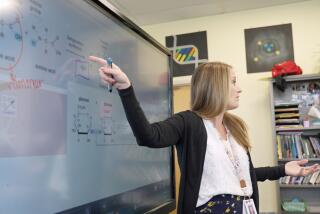Teaching Methods for Reading
* Congratulations to the professors who tell their student teachers that “phonics” is not a viable approach for teaching reading and that teaching children to “decode” (decipher) words they do not know or understand is instructionally irresponsible (Oct. 25).
The National Research Council’s latest report on the subject, “Preventing Reading Difficulties in Young Children,” clearly demonstrates three essential principles for learning to read in English: Both methods, whole language and phonics, must be used; “children’s ability to talk to each other and tell stories at 3 or 4 years (is) as relevant to their later reading success as their mastery of the alphabet, which need not be fully memorized so young”; and “wide-range and varied . . . experiences support and facilitate reading acquisition.”
Congratulations to those professors who are honest enough to tell their student teachers that teaching limited-English-proficient children to read in English through “phonics” is totally useless: LEP students cannot “hear” the sounds of the English language. These professors are exercising their right and their responsibility to academic freedom.
CARMEN SANCHEZ SADEK
Los Angeles
*
So, many student teachers are instructed to teach in the whole-language method despite the mandated phonics law. Not surprising. The law concerning Prop. 227 was greeted the same way. These cavalier attitudes by the “educational elite” are an affront to every taxpayer in California. What should be obvious is that the arrogance demonstrated by CSU Chancellor Charles B. Reed’s “experts” is only exceeded by their incompetence. Unfortunately, taxpaying citizens lack the power to confront university administrators and faculty responsible for the abject failure of our schools.
JOSEPH LEA
Associate Professor (Emeritus)
School of Education
Cal State Long Beach
More to Read
Sign up for Essential California
The most important California stories and recommendations in your inbox every morning.
You may occasionally receive promotional content from the Los Angeles Times.










